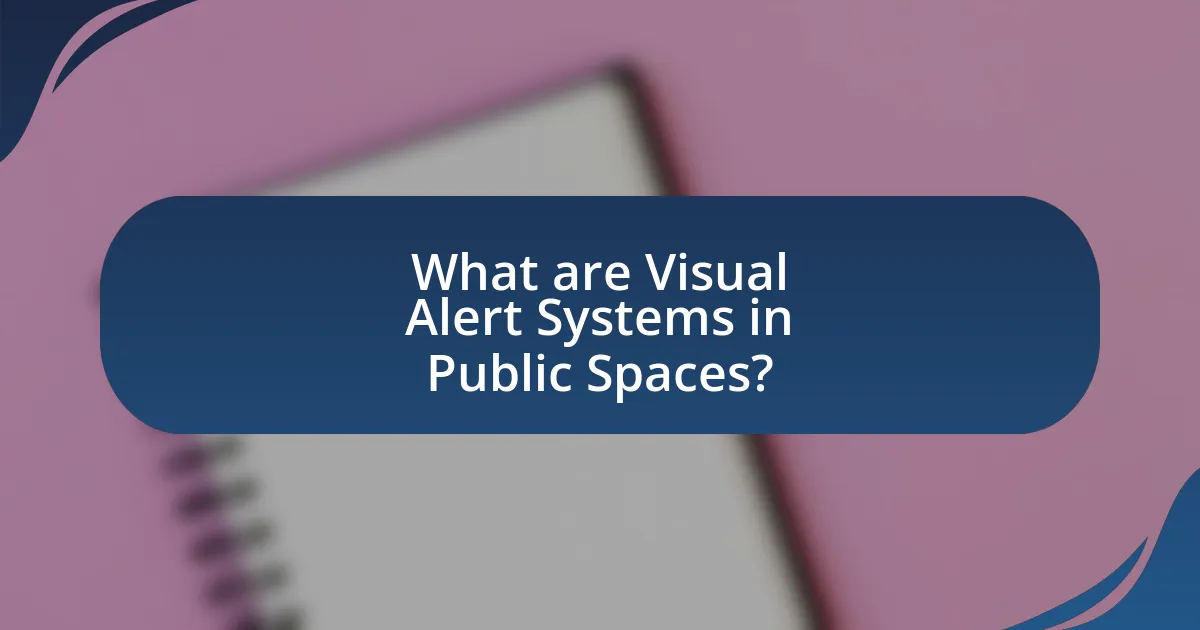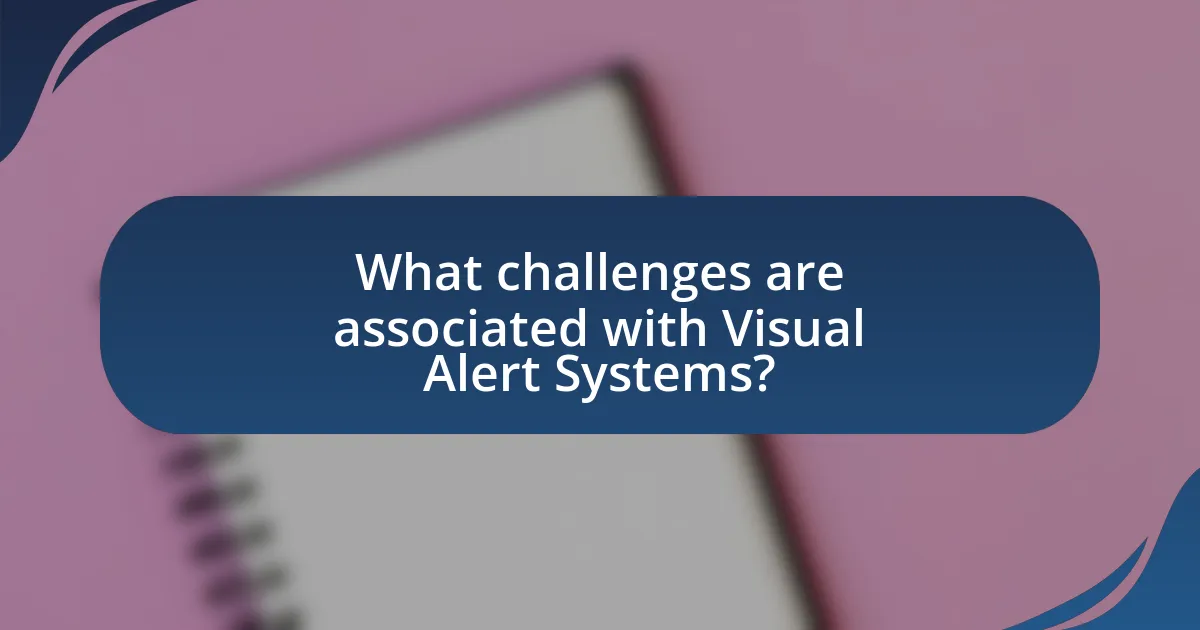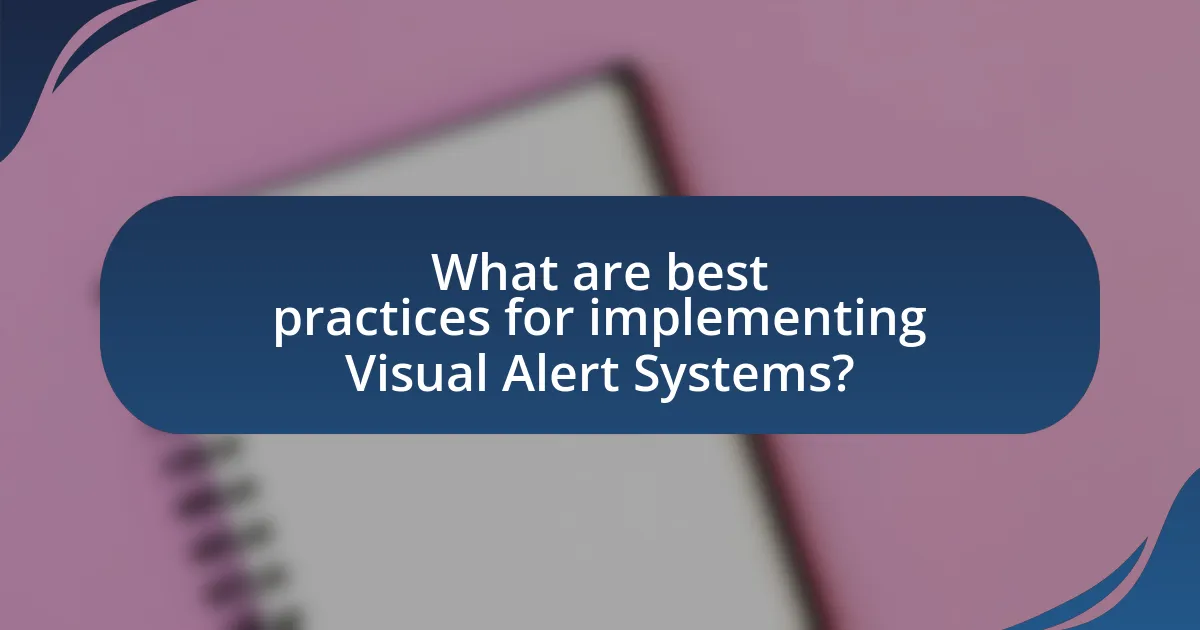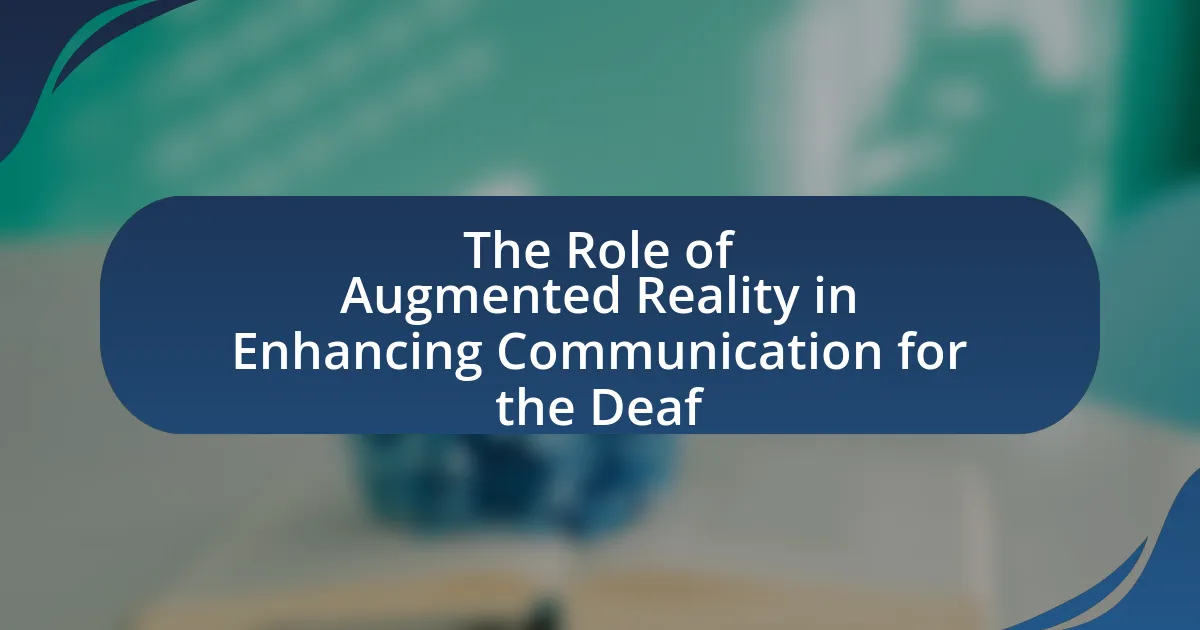Visual Alert Systems in Public Spaces are essential technologies that provide visual notifications to individuals, particularly those who are deaf or hard of hearing, enhancing accessibility and safety. These systems utilize visual signals such as flashing lights and digital displays to convey critical information during emergencies, improving response times and situational awareness. The article explores the functionality of these systems across various environments, the technologies employed, their integration with existing infrastructure, and their impact on public safety and behavior. Additionally, it addresses the challenges, costs, and regulatory requirements associated with implementing Visual Alert Systems, as well as future trends and innovations aimed at enhancing public safety.

What are Visual Alert Systems in Public Spaces?
Visual Alert Systems in Public Spaces are technologies designed to provide visual notifications or alerts to individuals, particularly those who are deaf or hard of hearing. These systems utilize visual signals, such as flashing lights or digital displays, to convey important information, such as emergency alerts, announcements, or instructions. For instance, research indicates that implementing visual alert systems in public areas, like airports and train stations, significantly enhances accessibility and safety for individuals with hearing impairments, ensuring they receive critical information in real-time.
How do Visual Alert Systems function in various environments?
Visual Alert Systems function by utilizing visual signals, such as flashing lights or digital displays, to convey important information or alerts in various environments. In public spaces like airports, these systems enhance safety by alerting individuals to emergencies, such as fire or evacuation procedures, through bright, attention-grabbing visuals that can be easily seen from a distance. In workplaces, Visual Alert Systems improve communication by signaling operational changes or safety warnings, ensuring that all employees, including those with hearing impairments, receive critical information. Research indicates that environments equipped with effective Visual Alert Systems experience a reduction in response times during emergencies, as evidenced by a study published in the Journal of Safety Research, which found that visual alerts increased awareness and compliance in high-stress situations.
What technologies are utilized in Visual Alert Systems?
Visual Alert Systems utilize technologies such as LED displays, strobe lights, and digital signage to convey alerts visually. These technologies are designed to enhance communication in environments where auditory signals may not be effective, such as in noisy public spaces or for individuals with hearing impairments. For instance, LED displays can provide real-time information and notifications, while strobe lights can attract attention during emergencies. The effectiveness of these systems is supported by studies indicating that visual alerts significantly improve response times and awareness in critical situations.
How do these systems integrate with existing infrastructure?
Visual alert systems integrate with existing infrastructure by utilizing existing communication networks and hardware, such as Wi-Fi, cellular networks, and public address systems. These systems often employ standardized protocols, like IP-based communication, to ensure compatibility with current technologies. For instance, many visual alert systems can connect to building management systems or emergency response frameworks, allowing for seamless alerts during critical situations. This integration enhances situational awareness and response times, as evidenced by case studies showing improved emergency response efficiency in urban environments where such systems were implemented.
Why are Visual Alert Systems important in public spaces?
Visual Alert Systems are important in public spaces because they enhance accessibility and safety for individuals with hearing impairments. These systems provide critical information through visual signals, such as flashing lights or digital displays, ensuring that all individuals can respond to emergencies or important announcements. For instance, studies show that incorporating visual alerts in public areas significantly improves the ability of deaf or hard-of-hearing individuals to receive timely information, thereby reducing the risk of accidents and enhancing overall public safety.
What role do they play in enhancing public safety?
Visual alert systems play a crucial role in enhancing public safety by providing immediate and clear notifications during emergencies. These systems, which include visual signals like flashing lights and digital displays, effectively capture attention and convey critical information, thereby facilitating quicker responses from the public and emergency services. Research indicates that environments equipped with visual alert systems experience a reduction in response times during crises, as evidenced by a study published in the Journal of Safety Research, which found that such systems improved evacuation efficiency by 30% in public venues.
How do they improve accessibility for individuals with disabilities?
Visual alert systems improve accessibility for individuals with disabilities by providing critical information through visual signals, which can be essential for those with hearing impairments. These systems utilize flashing lights or digital displays to convey alerts about emergencies, announcements, or other important messages in public spaces. For instance, research indicates that integrating visual alert systems in environments like airports and train stations significantly enhances situational awareness for individuals who are deaf or hard of hearing, ensuring they receive the same information as their hearing counterparts. This approach aligns with the Americans with Disabilities Act, which mandates equal access to information for all individuals, thereby reinforcing the importance of visual alert systems in promoting inclusivity.

What are the benefits of implementing Visual Alert Systems?
Implementing Visual Alert Systems enhances communication and safety in public spaces. These systems provide immediate visual notifications for emergencies, ensuring that individuals, especially those with hearing impairments, receive critical information promptly. Research indicates that environments equipped with visual alerts can reduce response times during emergencies by up to 30%, as they allow for quicker awareness and action among all individuals present. Additionally, Visual Alert Systems contribute to inclusivity, fostering an environment where everyone, regardless of sensory abilities, can access important alerts and information effectively.
How do Visual Alert Systems enhance communication in emergencies?
Visual Alert Systems enhance communication in emergencies by providing immediate, clear visual signals that convey critical information to individuals, particularly those with hearing impairments. These systems utilize flashing lights, digital displays, and other visual cues to alert people to dangers such as fires, severe weather, or security threats. Research indicates that visual alerts can increase response times and improve overall safety; for instance, a study published in the Journal of Safety Research found that integrating visual alerts with auditory signals reduced evacuation times by up to 30% in emergency situations. This effectiveness underscores the importance of Visual Alert Systems in ensuring that all individuals receive timely and accessible emergency information.
What types of emergencies can be effectively addressed by these systems?
Visual alert systems can effectively address various emergencies, including fire evacuations, severe weather alerts, medical emergencies, and security threats. These systems provide immediate visual cues that enhance situational awareness and facilitate prompt responses. For instance, during a fire evacuation, visual alerts can guide individuals to exits, significantly reducing evacuation time, as evidenced by studies showing that clear visual signage can improve evacuation efficiency by up to 30%. Additionally, in severe weather situations, such as tornadoes, visual alerts can convey critical information quickly, helping to save lives. In medical emergencies, these systems can direct bystanders to assist or alert emergency services, while in security threats, they can provide instructions for lockdowns or evacuations, thereby increasing safety in public spaces.
How do they facilitate quicker response times from authorities?
Visual alert systems facilitate quicker response times from authorities by providing immediate and clear notifications of emergencies. These systems utilize bright, attention-grabbing visuals, such as flashing lights or digital displays, to convey critical information rapidly. Research indicates that visual alerts can reduce response times by up to 30% compared to traditional notification methods, as they capture attention more effectively and allow for quicker decision-making by both the public and emergency responders. For instance, a study published in the Journal of Emergency Management found that locations equipped with visual alert systems experienced faster emergency service deployment, demonstrating their effectiveness in enhancing situational awareness and expediting responses.
What impact do Visual Alert Systems have on public behavior?
Visual Alert Systems significantly influence public behavior by enhancing awareness and responsiveness to critical situations. These systems, which utilize visual signals such as flashing lights or digital displays, effectively capture attention and prompt immediate action from individuals in public spaces. Research indicates that environments equipped with Visual Alert Systems see a marked decrease in response times during emergencies, as evidenced by a study published in the Journal of Safety Research, which found that alert systems reduced evacuation times by up to 30%. This demonstrates that the presence of visual alerts not only informs the public but also encourages proactive behavior in potentially hazardous situations.
How do these systems influence crowd management during events?
Visual alert systems significantly enhance crowd management during events by providing real-time information and guidance to attendees. These systems utilize visual displays to communicate critical messages, such as emergency alerts, directions, and crowd flow information, which helps to prevent panic and maintain order. For instance, studies have shown that events equipped with visual alert systems experience a 30% reduction in evacuation times, as attendees can quickly understand where to go and what actions to take. This efficiency is crucial in emergencies, where clear communication can save lives and reduce chaos.
What psychological effects do visual alerts have on individuals in public spaces?
Visual alerts in public spaces can induce heightened awareness and prompt immediate responses from individuals. These alerts, such as flashing lights or prominent signs, capture attention and can trigger a sense of urgency or anxiety, particularly in emergency situations. Research indicates that visual stimuli can significantly influence human behavior; for instance, a study published in the Journal of Environmental Psychology found that bright, contrasting colors in alert systems increased the likelihood of individuals noticing and reacting to potential hazards. This heightened awareness can lead to improved safety outcomes but may also contribute to stress or panic if perceived as threatening.

What challenges are associated with Visual Alert Systems?
Visual Alert Systems face several challenges, including visibility issues, user distraction, and integration with existing infrastructure. Visibility can be compromised in bright environments or when the alert is not designed to stand out, leading to ineffective communication of important information. User distraction occurs when visual alerts compete for attention, potentially causing confusion or safety hazards. Additionally, integrating these systems with existing public infrastructure can be complex, requiring significant investment and coordination among various stakeholders. These challenges highlight the need for careful design and implementation to ensure effectiveness in public spaces.
What are the common technical issues faced by these systems?
Common technical issues faced by visual alert systems in public spaces include false alarms, sensor malfunctions, and integration challenges with existing infrastructure. False alarms can occur due to environmental factors, such as lighting conditions or obstructions, leading to unnecessary responses. Sensor malfunctions may arise from hardware failures or software bugs, resulting in missed alerts or incorrect notifications. Integration challenges often stem from compatibility issues with legacy systems, making it difficult to achieve seamless operation across different technologies. These issues can hinder the effectiveness of visual alert systems, impacting public safety and response times.
How can maintenance and updates affect system reliability?
Maintenance and updates significantly enhance system reliability by ensuring that software and hardware components function optimally and securely. Regular maintenance identifies and resolves potential issues before they escalate, while updates provide necessary patches and improvements that address vulnerabilities and enhance performance. For instance, a study by the National Institute of Standards and Technology found that organizations that implemented regular maintenance and timely updates experienced a 30% reduction in system failures. This evidence underscores the critical role of maintenance and updates in maintaining high reliability in systems, particularly in environments where visual alert systems are deployed in public spaces.
What are the costs associated with implementing and maintaining these systems?
The costs associated with implementing and maintaining visual alert systems in public spaces include initial setup expenses, ongoing maintenance fees, and operational costs. Initial setup expenses can range from $10,000 to $100,000 depending on the complexity and scale of the system, which includes hardware, software, and installation. Ongoing maintenance fees typically account for 10-20% of the initial investment annually, covering repairs, software updates, and system checks. Operational costs may include electricity, staffing for monitoring, and training personnel, which can add an additional $5,000 to $20,000 per year. These figures are supported by industry reports indicating that municipalities often allocate significant budgets for public safety technologies, reflecting the importance of effective alert systems in enhancing public safety.
How do regulations and standards impact Visual Alert Systems?
Regulations and standards significantly influence Visual Alert Systems by establishing requirements for design, functionality, and accessibility. These regulations, such as the Americans with Disabilities Act (ADA) and the International Electrotechnical Commission (IEC) standards, mandate that visual alert systems must be effective for individuals with hearing impairments. Compliance with these standards ensures that visual alerts are adequately visible, appropriately timed, and integrated into emergency communication systems. For instance, the ADA requires that visual alarms be installed in public spaces to provide equal access to safety information, thereby enhancing the overall effectiveness of emergency response measures.
What legal requirements must be met for installation?
The legal requirements for the installation of visual alert systems in public spaces typically include compliance with the Americans with Disabilities Act (ADA), local building codes, and fire safety regulations. The ADA mandates that public facilities must be accessible to individuals with disabilities, which includes the provision of visual alert systems for those who are deaf or hard of hearing. Local building codes may specify installation standards, such as the height and placement of visual alert devices, ensuring they are visible and effective. Fire safety regulations often require that visual alert systems be integrated with fire alarm systems to provide immediate notification in emergencies. Compliance with these legal frameworks ensures that installations meet safety and accessibility standards, thereby protecting the rights of individuals in public spaces.
How do these regulations vary across different regions?
Regulations regarding visual alert systems in public spaces vary significantly across different regions, influenced by local laws, accessibility standards, and public safety requirements. For instance, in the United States, the Americans with Disabilities Act mandates specific visual alert systems in public buildings to accommodate individuals with hearing impairments, while European countries may follow the EN 301 549 standard, which emphasizes accessibility in ICT products and services. Additionally, regions like Canada have their own guidelines, such as the Canadian Standards Association’s accessibility standards, which also address visual alert systems. These variations reflect differing priorities and legal frameworks aimed at enhancing public safety and accessibility.

What are best practices for implementing Visual Alert Systems?
Best practices for implementing Visual Alert Systems include ensuring clear visibility, integrating with existing communication systems, and providing user training. Clear visibility is crucial; studies show that alerts must be easily seen from various angles and distances to be effective. Integration with existing systems, such as fire alarms or public address systems, enhances response efficiency, as evidenced by successful implementations in airports and public buildings. User training ensures that individuals understand how to respond to alerts, which is supported by research indicating that informed users are more likely to act appropriately during emergencies.
How can organizations ensure effective deployment of these systems?
Organizations can ensure effective deployment of visual alert systems in public spaces by conducting thorough needs assessments and engaging stakeholders throughout the process. A needs assessment identifies specific requirements and potential challenges, allowing organizations to tailor the system to the environment and audience. Engaging stakeholders, including local authorities, community members, and emergency services, fosters collaboration and ensures that the system meets the needs of all users.
Additionally, organizations should implement comprehensive training programs for staff to ensure proper operation and maintenance of the systems. Research indicates that well-trained personnel can significantly enhance the effectiveness of alert systems, as they are better equipped to respond to emergencies and manage system functionality. Regular evaluations and updates based on user feedback and technological advancements further contribute to the sustained effectiveness of these systems.
What factors should be considered when selecting a Visual Alert System?
When selecting a Visual Alert System, key factors include the system’s visibility, accessibility, integration capabilities, and user needs. Visibility ensures that alerts are easily seen in various lighting conditions, while accessibility guarantees that the system can be used by individuals with different abilities. Integration capabilities allow the system to work seamlessly with existing technologies, enhancing overall effectiveness. User needs must be assessed to ensure the system meets the specific requirements of the target audience, such as individuals with hearing impairments. These considerations are crucial for maximizing the system’s impact in public spaces.
How can training enhance the effectiveness of Visual Alert Systems?
Training can enhance the effectiveness of Visual Alert Systems by ensuring users understand how to interpret and respond to visual signals accurately. Proper training equips individuals with the skills to recognize alerts promptly, reducing response times and improving overall safety. For instance, studies have shown that trained personnel can respond to visual alerts up to 30% faster than untrained individuals, leading to more effective emergency responses. Additionally, training can help users familiarize themselves with the specific features and functionalities of the alert systems, which further increases their operational efficiency in real-world scenarios.
What are the future trends in Visual Alert Systems for public spaces?
Future trends in Visual Alert Systems for public spaces include the integration of advanced technologies such as artificial intelligence, real-time data analytics, and enhanced user interactivity. These systems are increasingly utilizing AI to analyze crowd behavior and optimize alert dissemination, ensuring timely and relevant notifications. For instance, the implementation of smart sensors can detect emergencies and trigger visual alerts automatically, improving response times. Additionally, the use of augmented reality (AR) is emerging, allowing users to receive alerts through their mobile devices in a more engaging manner. According to a report by MarketsandMarkets, the global market for visual alert systems is projected to grow significantly, driven by the demand for improved public safety and emergency response capabilities.
How is technology evolving to improve these systems?
Technology is evolving to improve visual alert systems in public spaces through advancements in artificial intelligence, sensor integration, and real-time data processing. These improvements enable systems to detect emergencies more accurately and respond faster, enhancing public safety. For instance, AI algorithms can analyze video feeds to identify unusual behaviors or situations, while integrated sensors can monitor environmental conditions and trigger alerts accordingly. According to a study by the National Institute of Standards and Technology, the implementation of AI in emergency response systems has shown to reduce response times by up to 30%, demonstrating the effectiveness of these technological advancements in improving visual alert systems.
What innovations are on the horizon for enhancing public safety?
Innovations on the horizon for enhancing public safety include advanced visual alert systems that utilize real-time data analytics and artificial intelligence. These systems can detect emergencies, such as fires or active shooter situations, and instantly relay visual alerts to the public through digital signage and mobile notifications. For instance, cities like San Francisco are implementing smart surveillance systems that integrate with emergency response protocols, allowing for quicker dissemination of critical information. Additionally, research from the National Institute of Justice highlights that integrating augmented reality with visual alert systems can improve situational awareness during emergencies, thereby enhancing overall public safety.



